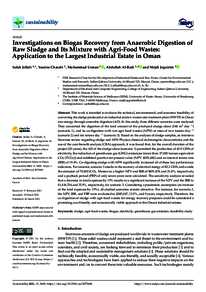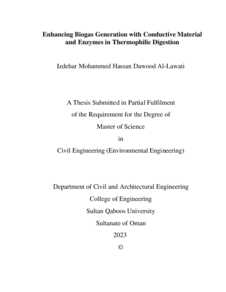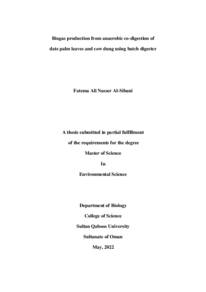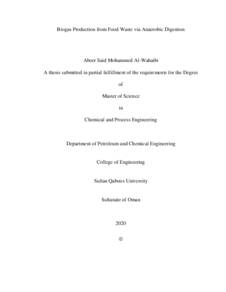وثيقة
Enhanced biogas production from animal waste using a gas-membrane absorption anaerobic reactor.
المعرف
DOI: 10.1063/5.0066601
المصدر
AIP Conference Proceedings. v. 2396, 020003
المساهمون
الدولة
United States.
مكان النشر
Maryland
الناشر
American Institute of Physics Inc.
ميلادي
2021-09-28
اللغة
الأنجليزية
الملخص الإنجليزي
Biogas is a renewable energy source that usually consists of Biogas is made up of (60-70%) methane gas and carbon dioxide (CO2) (30-35%) and other gases such as hydrogen, nitrogen, and traces of hydrogen sulphide and ammonia, produced by the decomposition of organic matter such as food or animal waste. In this study, a digester reactor will be developed to produce biogas and benefit from the fertilizer produced from the reactor using animal waste. Animal dung is a valuable source of nutrients and renewable energy. However, it is left to decompose in the open without benefiting from it, causing serious environmental problems, but its use as a raw material in the production of biogas will return to the community of many benefits and eliminate environmental problems. Furthermore, most of the energy needs in Oman is met from the fossil fuels and LPG which are non-renewable energy types of sources which may end one day, biogas which is a renewable energy to some extent can replace LPG. Biogas is a colourless, light gas (half the air density) that ignites in the air as a very high-temperature, blue flame that does not pollute the environment. Its thermal capacity is 5513 kcal/m3. Biogas can widely use in different walks of life such as cooking, electricity generation, produce heat, and some agriculture uses. Experiment was conducted in a laboratory scale 6 L bioreactor, to test the effectiveness of horse dung in biogas production. Experiment was done to test a horse dung slurry as an inoculum for the bioreactor with ethanol. The results obtained show that the gas production has increased with respect to the number of days with the highest production of biogas was obtained after the addition of ethanol as a catalyst for decomposition, which amounted to 2095 ml during the last five days.
ISSN
0094-243X
قالب العنصر
مقالات الدوريات





